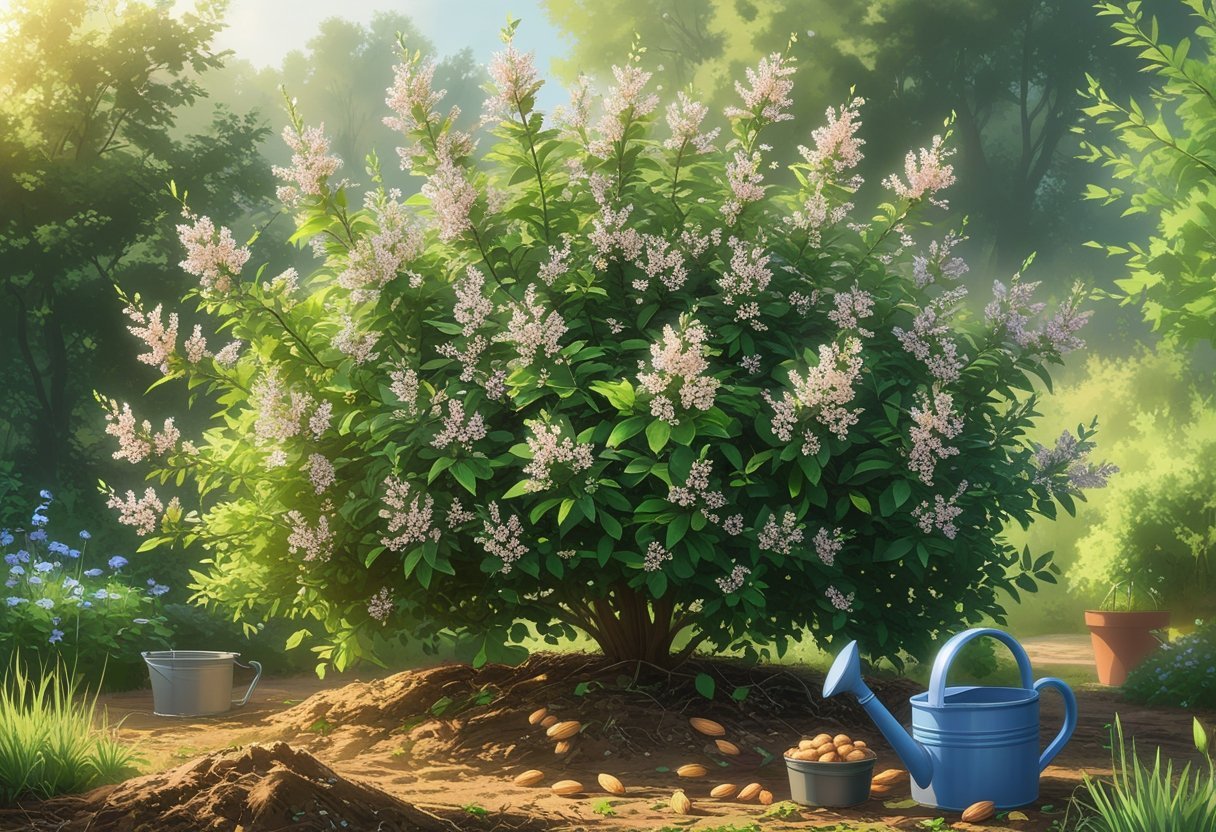The sweet almond bush is a tough, good-looking shrub with fragrant white blooms, and honestly, it’s a breeze to grow if you’re in a warm spot. Once it’s settled in, you won’t need to water it much, and it’ll be happiest soaking up full sun in well-draining soil. Give it moderate irrigation, trim it back now and then to keep it from getting scraggly, and make sure it gets a solid 6–8 hours of sunlight a day.

This shrub’s pretty adaptable to heat and can stretch up to 12 feet tall and wide—definitely makes a statement in most gardens. If you keep up with some trimming between bloom cycles, you’ll help it stay neat and push out thicker, healthier foliage.
Key Takeways
- Thrives with moderate watering and lots of sun
- Occasional pruning keeps it full and prevents legginess
- Heat-hardy, so it’s great for warmer gardens
Essential Sweet Almond Bush Care
If you want your sweet almond bush to really show off, you’ll need to dial in the basics: light, soil, and watering. Get these right, and you’ll have a happy, fragrant shrub.
Light and Sun Requirements
This plant’s a sun lover—aim for at least six hours of direct sunlight. A warm, sunny spot is best for those full blooms and thick leaves.
Stick it in too much shade and you’ll probably see fewer flowers and lankier growth. Indoors or in deep shade? Not really ideal unless you’ve got some serious grow lights.
I usually try to give mine morning sun and a bit of afternoon light. That way, it gets what it needs without frying in scorching heat.
Soil Selection and Preparation
You really don’t want soggy roots, so well-draining soil is key. Sandy or loamy mixes work great—avoid heavy clay unless you’re willing to amend it.
Sweet almond bush likes soil that’s slightly acidic to neutral, somewhere in the 6.0 to 7.0 pH range. Mixing in compost or peat moss can help with texture and nutrients.
Before planting, I like to break up the soil and toss in some compost. If your soil’s compacted or heavy, consider a raised bed or mound to keep things draining well.
Watering Techniques
Don’t go overboard with the hose. Let the top inch or two of soil dry out before watering again. Too much water? You’ll risk root rot. Too little? You’ll see droopy leaves and fewer flowers.
Usually, once or twice a week is fine during the growing season, but it really depends on your climate and soil. I prefer to water early in the morning—less evaporation, and the roots have time to soak it up.
A layer of mulch helps keep moisture in and roots cool. If you’re getting a lot of rain, back off on watering so you don’t end up with soggy soil.
Growing and Maintaining Sweet Almond Bush
Once you’ve got the basics down, a little ongoing care goes a long way—think pruning, feeding, and keeping an eye out for pests.
Pruning and Shaping
Pruning’s your best friend if you want a full, tidy bush with lots of flowers. I usually do it in late winter or early spring, before new growth really kicks in. Snip out anything dead or weak to help air and light get where they need to go.
A light trim here and there keeps the plant from getting too leggy. If you shear the tips, you’ll see bushier growth. Just try not to go overboard during blooming—nobody wants to lose those flowers.
Sharp, clean tools are a must. Check in on your plant now and then and prune as needed to keep the size in check.
Fertilization and Feeding
Sweet almond bush isn’t super needy, but a little fertilizer during the growing season makes a difference. I go for a balanced fertilizer (equal parts nitrogen, phosphorus, potassium) every month or so from spring through early fall.
If you’re into organics, compost or well-rotted manure is great for slow-release nutrients and better soil. Don’t dump on too much nitrogen though—otherwise, you’ll get lots of leaves and not many flowers.
Always water well after feeding to help the nutrients reach the roots. If the leaves are looking pale or growth seems slow, you might need to feed a bit more often, but don’t overdo it.
Pest and Disease Management
Sweet almond bush is usually pretty tough, but let’s be real—aphids, spider mites, and scale insects can still show up. Catching these early makes life a lot easier.
I like to go with insecticidal soap or neem oil; they do the job without wrecking the environment. Keep an eye out for weird spots or damage on the leaves and stems—sometimes you have to look close.
Fungal diseases don’t pop up too often, unless your soil stays soggy or drainage is just bad. Giving your plants enough space and making sure water doesn’t stick around too long really helps. If you spot something funky, just trim off the bad parts and toss them—don’t let that stuff linger.




